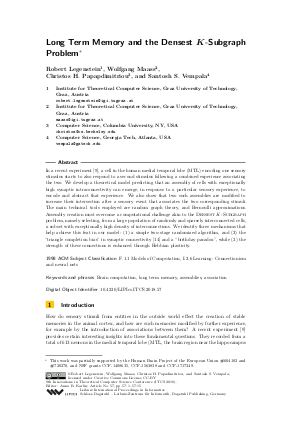Long Term Memory and the Densest K-Subgraph Problem
Authors Robert Legenstein, Wolfgang Maass, Christos H. Papadimitriou, Santosh S. Vempala
-
Part of:
Volume:
9th Innovations in Theoretical Computer Science Conference (ITCS 2018)
Part of: Series: Leibniz International Proceedings in Informatics (LIPIcs)
Part of: Conference: Innovations in Theoretical Computer Science Conference (ITCS) - License:
 Creative Commons Attribution 3.0 Unported license
Creative Commons Attribution 3.0 Unported license
- Publication Date: 2018-01-12
File

PDF
LIPIcs.ITCS.2018.57.pdf
- Filesize: 0.65 MB
- 15 pages
Document Identifiers
Subject Classification
Keywords
- Brain computation
- long term memory
- assemblies
- association
Metrics
- Access Statistics
-
Total Accesses (updated on a weekly basis)
0Document
0Metadata
Abstract
In a recent experiment, a cell in the human medial temporal lobe (MTL) encoding one sensory stimulus starts to also respond to a second stimulus following a combined experience associating the two. We develop a theoretical model predicting that an assembly of cells with exceptionally high synaptic intraconnectivity can emerge, in response to a particular sensory experience, to encode and abstract that experience. We also show that two such assemblies are modified to increase their intersection after a sensory event that associates the two corresponding stimuli. The main technical tools employed are random graph theory, and Bernoulli approximations. Assembly creation must overcome a computational challenge akin to the Densest K-Subgraph problem, namely selecting, from a large population of randomly and sparsely interconnected cells, a subset with exceptionally high density of interconnections. We identify three mechanisms that help achieve this feat in our model: (1) a simple two-stage randomized algorithm, and (2) the "triangle completion bias" in synaptic connectivity and a "birthday paradox", while (3) the strength of these connections is enhanced through Hebbian plasticity.
Cite As Get BibTex
Robert Legenstein, Wolfgang Maass, Christos H. Papadimitriou, and Santosh S. Vempala. Long Term Memory and the Densest K-Subgraph Problem. In 9th Innovations in Theoretical Computer Science Conference (ITCS 2018). Leibniz International Proceedings in Informatics (LIPIcs), Volume 94, pp. 57:1-57:15, Schloss Dagstuhl – Leibniz-Zentrum für Informatik (2018)
https://doi.org/10.4230/LIPIcs.ITCS.2018.57
BibTex
@InProceedings{legenstein_et_al:LIPIcs.ITCS.2018.57,
author = {Legenstein, Robert and Maass, Wolfgang and Papadimitriou, Christos H. and Vempala, Santosh S.},
title = {{Long Term Memory and the Densest K-Subgraph Problem}},
booktitle = {9th Innovations in Theoretical Computer Science Conference (ITCS 2018)},
pages = {57:1--57:15},
series = {Leibniz International Proceedings in Informatics (LIPIcs)},
ISBN = {978-3-95977-060-6},
ISSN = {1868-8969},
year = {2018},
volume = {94},
editor = {Karlin, Anna R.},
publisher = {Schloss Dagstuhl -- Leibniz-Zentrum f{\"u}r Informatik},
address = {Dagstuhl, Germany},
URL = {https://drops.dagstuhl.de/entities/document/10.4230/LIPIcs.ITCS.2018.57},
URN = {urn:nbn:de:0030-drops-83593},
doi = {10.4230/LIPIcs.ITCS.2018.57},
annote = {Keywords: Brain computation, long term memory, assemblies, association}
}
Author Details
References
-
Robert C Berwick and Noam Chomsky. Why only us: Language and evolution. MIT Press, 2016.

-
Béla Bollobás. Random graphs. In Modern Graph Theory, pages 215-252. Springer, 1998.

-
G Buzsaki. Neural syntax: cell assemblies, synapsembles, and readers. Neuron, 68(3), 2010.

-
Uriel Feige, David Peleg, and Guy Kortsarz. The dense k-subgraph problem. Algorithmica, 29(3):410-421, 2001.

-
Kevin M Franks, Marco J Russo, Dara L Sosulski, Abigail A Mulligan, Steven A Siegelbaum, and Richard Axel. Recurrent circuitry dynamically shapes the activation of piriform cortex. Neuron, 72(1):49-56, 2011.

-
Alan Frieze and Michał Karoński. Introduction to random graphs. Cambridge University Press, 2015.

-
S Guzman, A J Schlö gl, M Frotscher, and P Jonas. Synaptic mechanisms of pattern completion in the hippocampal ca3 network. Science, 353(6304):1117-1123, 2016.

-
Donald Olding Hebb. The organization of behavior: A neuropsychological theory. Wiley, New York, 1949.

-
Matias J Ison, Rodrigo Quian Quiroga, and Itzhak Fried. Rapid encoding of new memories by individual neurons in the human brain. Neuron, 87(1):220-230, 2015.

-
Robert Legenstein, Christos H Papadimitriou, Santosh Vempala, and Wolfgang Maass. Assembly pointers for variable binding in networks of spiking neurons. arXiv preprint arXiv:1611.03698, 2016.

-
A. Litwin-Kumar and B. Doiron. Formation and maintenance of neuronal assemblies through synaptic plasticity. Nature communications, 5, 2014.

-
Rodrigo Quian Quiroga. Concept cells: the building blocks of declarative memory. Nature Reviews Neurosci., 13(8):587-597, 2012.

-
Rodrigo Quian Quiroga. Neuronal codes for visual perception and memory. Neuropsychologia, 83:227-241, 2016.

-
S. Song, P. J. Sjöström, M. Reigl, S. Nelson, and D. B. Chklovskii. Highly nonrandom features of synaptic connectivity in local cortical circuits. PLoS Biology, 3(3):e68, 2005.

-
Leslie G. Valiant. A neuroidal architecture for cognitive computation. J. ACM, 47(5):854-882, 2000.

- Emiliano Zaccarella, Lars Meyer, Michiru Makuuchi, and Angela D. Friederici. Building by syntax: The neural basis of minimal linguistic structures. Cerebral Cortex, 27(1):411-421, 2017. URL: http://dx.doi.org/10.1093/cercor/bhv234.
-
F. Zenke, E. J. Agnes, and W. Gerstner. Diverse synaptic plasticity mechanisms orchestrated to form and retrieve memories in spiking neural networks. Nature communications, 6, 2015.

